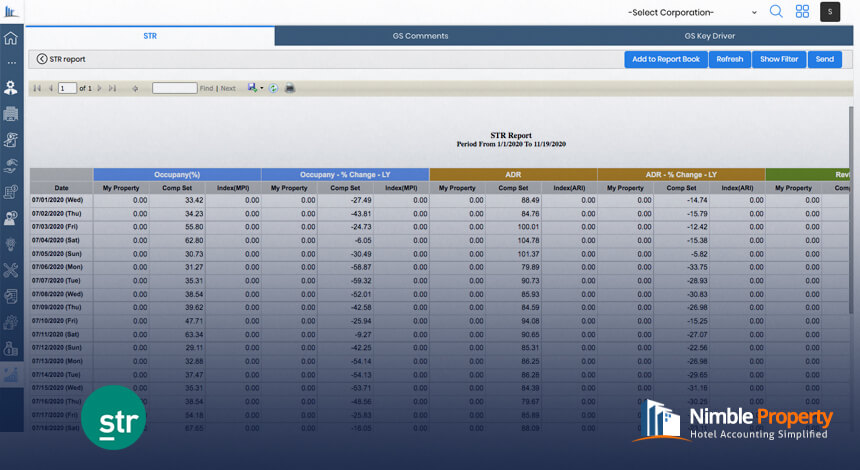STR has been defined by the Smith Travel Research as “a measure of demand, not supply,” which makes it a great tool in comparing a hotel’s performance to that of its peers. STR measures occupied room nights, or units sold into the market that are recognized as revenue. STR calculates actual arrivals by measuring cash receipts from guests staying at hotels and includes direct sales to customers who paid for their rooms with cash or equivalent forms of payment such as traveller’s checks, credit-card payments and refunds or rebates. STR does not include incremental amounts derived from group contracts where final settlement has not occurred according to STR rules.
In other words, STR is a report from Smith Travel Research Inc. It can be used to compare your hotel’s performance with that of your peers (STR is not the end-all; it is one of many tools you can use to measure performance). STR measures occupied room nights, or units sold into the market that are recognized as revenue. STR calculates actual arrivals by measuring cash receipts from guests staying at hotels and includes direct sales to customers who paid for their rooms with cash or equivalent forms of payment such as traveller’s checks, credit-card payments and refunds or rebates. STR does not include incremental amounts derived from group contracts where final settlement has not occurred according to STR rules.
How to Read a STR Report in hotels?
These STR reports are used by hotel owners to determine if they are receiving the profits that they desire. Perhaps you own a hotel and you have been using STR reports for some time now, but your numbers aren’t where you want them to be.
If this is the case, then there may be something wrong with how these STR reports are being read.
We will go through an example of an STR report so that it may become clearer as to what your STR means.
The first thing that will appear on an STR report is the address of each visiting group/family/room number listed within this section.
The next thing on the STR will be “Date requests.” What this refers to is the date on which the hotel guest made their STR request.
This will be categorised by day, month, year and number of guests in this section.
Next is the “Occupancy” section. This refers to how many people are currently occupying the hotel room/room type that is being recorded on this STR report.
After occupancy comes the next category entitled “Contracted Rate.” This is how much money was charged to each visitor for staying at your hotel for one night/week/month/season or any other time that they may have paid for when they arrived.
The next section will refer to what percentage of rooms were occupied during a specific time frame – usually a week or month.
If all of your contracted rooms were occupied, then this section will read 100%.
After occupancy comes the next category entitled “Revenue Generating Rooms.” This is a number of rooms that generated revenue for your hotel.
This includes rooms which were occupied as well as those rooms that were not occupied. The last STR report section will be entitled “Direct Expenses.” This simply refers to the amount of money that it cost you to have all of these visiting groups at your hotel.
It is important to realize that the STR report does not include monthly expenses such as mortgage payments on a house or car payment on a vehicle. These Hotel reports only focus on what it costs you to keep a room filled with guests. There are some who will inform STR report readers of the amount paid out in monthly expenses, but it will typically be listed separately and not included on the STR.
Now that we have gone over STR reports, perhaps you can read one and determine if there is something wrong with your hotel’s occupancy rate or whether or not your profits are as high as they should be.
If this is the case, then hopefully reading an STR report has helped to bring some clarity into why these numbers may be down and how you can go about changing them for the better.
Although STR reports are used by hotels, almost any business could benefit from using STR reports to determine what changes need to be made so as to improve their earnings/margins/profitability/sales etc.
Nimble Property lets you seamlessly import you STR into the system so you can keep a tab on it to review your hotel performance status in the market, against you competitors. Get a competitive set of all your hotel group properties at once place.
It takes few seconds and clicks to view your entire business portfolio’s occupancy%, average daily rate (ADR) and RevPAR info against your aggregated performance of the selected competitive hotels.
What are you waiting for? Come, start reading your STR report today. Schedule a demo how to do it!

